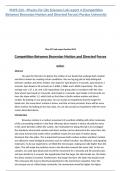Exam (elaborations)
PHYS 233 - Physics for Life Sciences Lab report 4 (Competition Between Brownian Motion and Directed Forces) Purdue University
- Course
- Institution
PHYS 233 - Physics for Life Sciences Lab report 4 (Competition Between Brownian Motion and Directed Forces) Purdue University
[Show more]



